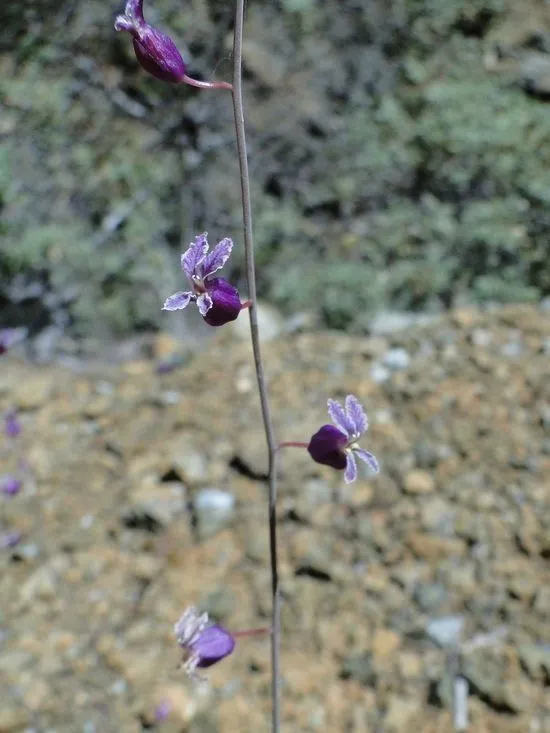
Author: Hook.
Bibliography: Hooker’s Icon. Pl. 1: t. 40 (1836)
Year: 1836
Status: accepted
Rank: species
Genus: Streptanthus
Vegetable: False
Observations: Oregon to California
The Jewel-flower, scientifically named Streptanthus glandulosus, is an exquisite member of the Brassicaceae family. First described in Hooker’s Icon. Pl. 1: t. 40 in 1836 by the botanist Hook., this captivating plant is native to the regions spanning from Oregon to California.
Jewel-flower is a herbaceous annual plant noted for its striking appearance. The plant’s stems are often solitary and can grow to various heights depending on environmental conditions, creating a rather delicate yet imposing presence in its natural habitat. One of the most distinctive features of Streptanthus glandulosus is its unique, glandular-hairy stems and leaves. This glandularity is not only a key identifying characteristic but also contributes to the plant’s common name, reflecting its jewel-like sparkle in the sunlight.
The inflorescences of the Jewel-flower are truly a marvel to behold. They typically consist of numerous small flowers borne on racemes that can range in color but often exhibit lovely hues of purple, rarely white or yellow. Each flower comprises four petals that, together with the plant’s glandular trichomes, give it a unique and ornate appearance. The flowers mature into slender, erect siliques (seed pods), which further add to the plant’s ornamental value.
In its native range, the Jewel-flower thrives in a variety of habitats including grasslands, woodlands, and chaparral. It is particularly well-adapted to the serpentine soils prevalent in parts of its range, which are often low in essential nutrients. This adaptability showcases the plant’s resilience and its capacity to flourish in less than ideal growing conditions, making it a fascinating subject for botanists and plant enthusiasts alike.
Despite its beauty, the Jewel-flower is modest in terms of its propagation and care in cultivated settings. Gardeners interested in introducing this species into their landscape will need to replicate its native conditions closely, ensuring well-drained soil and a position that receives ample sunlight.
In conclusion, Streptanthus glandulosus, or the Jewel-flower, is a remarkable specimen of the Brassicaceae family. Its elegant glandular features, combined with its adaptability and natural charm, make it a prized find from Oregon to California. Whether observed in the wild or cultivated in a garden, this plant continues to captivate those who understand its unique beauty and ecological significance.
Eng: bristly jewelflower, jewel-flower
En: Jewel-flower, Bristly jewelflower
Taken Jun 1, 2014 by EOL − Ken-ichi Ueda (cc-by-nc)
Taken Apr 11, 2021 by Reina Carmen (cc-by-sa)
Taken Jun 4, 2003 by EOL − Bart and Susan Eisenberg (cc-by)
Taken Dec 1, 1998 by EOL − Charles Webber (cc-by-nc-sa)
Taken Mar 19, 1998 by EOL − John Game (cc-by-sa)
Taken Apr 29, 2020 by Toby Ralph (cc-by-sa)
Taken May 18, 2012 by EOL − Don Loarie (cc-by)
Taken Feb 3, 2010 by EOL − Zoya Akulova (cc-by-nc)
Taken Jun 10, 2014 by EOL − Amelia Ryan (cc-by-nc)
Taken Jun 10, 2014 by EOL − Amelia Ryan (cc-by-nc)
Taken Jun 10, 2014 by EOL − Amelia Ryan (cc-by-nc)
Taken Mar 21, 2013 by EOL − Scot Loring (cc-by-nc)
Taken Mar 21, 2013 by EOL − Scot Loring (cc-by-nc)
Taken Apr 4, 2010 by EOL − Ken-ichi Ueda (cc-by-nc-sa)
Taken May 18, 2012 by EOL − Don Loarie (cc-by)
Taken Dec 20, 2008 by EOL − Keir Morse (cc-by-nc-sa)
Taken Oct 6, 2015 by EOL − Hayley Ross (cc-by-nc-sa)
Taken Dec 20, 2008 by EOL − Keir Morse (cc-by-nc-sa)
Taken Jan 2, 2016 by EOL − Barry Breckling (cc-by-nc-sa)
© copyright of the Board of Trustees of the Royal Botanic Gardens, Kew.
Growth habit>: Forb/herb
Family: Myrtaceae Author: (F.Muell.) K.D.Hill & L.A.S.Johnson Bibliography: Telopea 6: 402 (1995) Year: 1995 Status:…
Family: Rubiaceae Author: Pierre ex A.Froehner Bibliography: Notizbl. Bot. Gart. Berlin-Dahlem 1: 237 (1897) Year:…
Family: Sapindaceae Author: Koidz. Bibliography: J. Coll. Sci. Imp. Univ. Tokyo 32(1): 38 (1911) Year:…
Family: Asteraceae Author: A.Gray Bibliography: Pacif. Railr. Rep.: 107 (1857) Year: 1857 Status: accepted Rank:…
Family: Fabaceae Author: Medik. Bibliography: Vorles. Churpfälz. Phys.-Ökon. Ges. 2: 398 (1787) Year: 1787 Status:…
Family: Aspleniaceae Author: (Cav.) Alston Bibliography: Bull. Misc. Inform. Kew 1932: 309 (1932) Year: 1932…